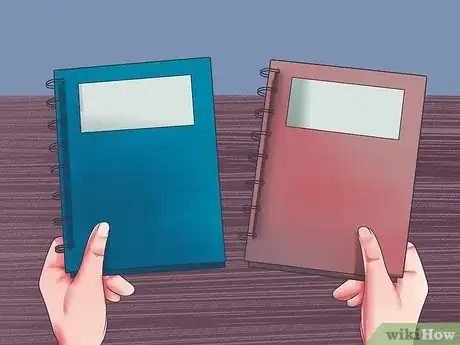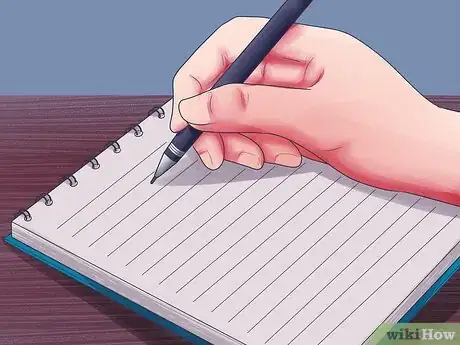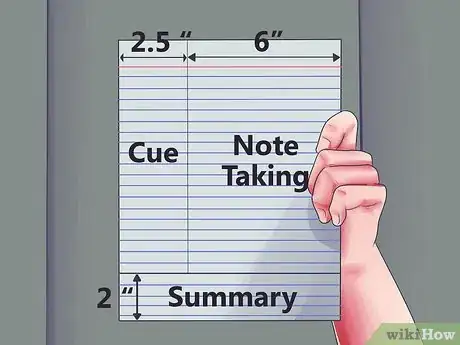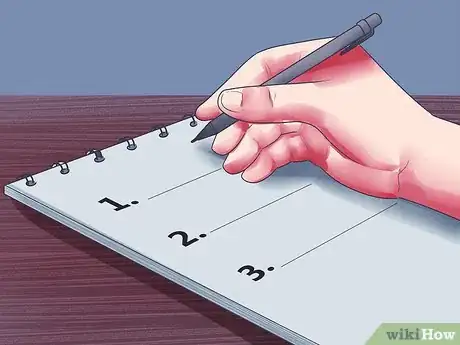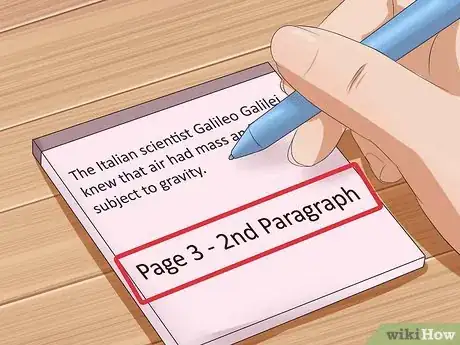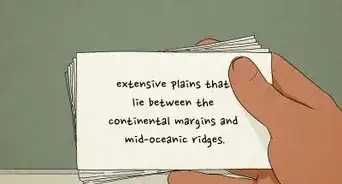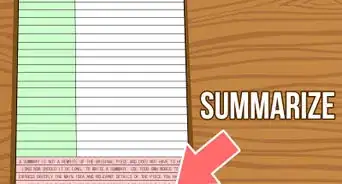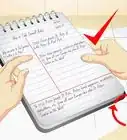X
wikiHow is a “wiki,” similar to Wikipedia, which means that many of our articles are co-written by multiple authors. To create this article, 11 people, some anonymous, worked to edit and improve it over time.
This article has been viewed 48,281 times.
Learn more...
Taking notes for a science class requires organization and practice. As you gain experience taking notes, they can aid mastery of the topic both during note-taking and later when you are working problems and studying for tests. Here are some tips on how to take good science notes.
Steps
Method 1
Method 1 of 2:
Getting Started
-
1Have a separate notebook for science. It can get confusing when you have all your notes from all your subjects crammed into one notebook. You might want to think about having a separate notebook for all your subjects, so your science notes don't get mixed up with your math and language arts notes.[1]
-
2Start a brand new page for a new topic. It doesn't matter if the last section stopped halfway through a page, that subject of notes has ended and you need to start a new page. This will prevent any confusion about what subject is what when going back to your notes to study off of later.[2]
- When a subject is continued onto a new piece of paper, add the word continued next to the title. For example, "Osmosis in Cells."
- Make sure you title your page at the right-hand side of your paper and date it on the left-hand side of your paper.
- Use an arrow - preferably in a different color, such as red - at the bottom of your page to indicate that your notes are continued onto the next page.
- Always use the back of your paper; not only will it save trees, but it will also save money too. And who doesn't want to save money?
Advertisement -
3Choosing a note-taking method. Taking notes isn't inscribed in ancient text, and there is no right way to take notes. But there is a more efficient way depending on where you taking notes from, such as a lecture, book, or textbook. There are four good ways to take notes and they are:[3]
- An outline. An outline is good for when you taking notes in class because you have an organized format to layout subheadings, key concepts, keywords. vocabulary, details, summaries, etc.
- Cornell method. The Cornell method is a good note-taking strategy for taking notes during a lecture because of the way it is designed. The Cornell method divides your paper into three sections: the "Cue Column", the "Note-Taking Section", and the "Summary Row". The Cue Column is written before class because this is where you write any questions you may have, anything you do not understand, and for key details. The Note-Taking is taken during class, this is where you write all your notes. and the Summary Row is written after class because you will summarize everything in the Note-taking Section and the Cue Column.
- The "T" Method. The "T" Method is good for when you are taking notes in class because of the way it is formatted. The "T" Method divides your page into two section instead of three like the Cornell Method. The right-hand side is used for subheadings and key concepts of that subheading. And the left-hand side is used for an expansion your notes in the right-hand side.
- The SQ3R Method. The SQ3R is a useful note-taking method for taking notes from a textbook because it makes you really think and comprehend what the text is about. SQ3R stands for Survey, Question, and the three R's - Read, Recite, and Review.
- Mindmapping. This note-taking method is good taking notes on a book, textbook, or lectures/in-class discussions. Mindmapping is a good note-taking method for visual learners because it is a way to visualize your notes.
Advertisement
Method 2
Method 2 of 2:
Taking Science Notes
-
1Leave space. When you back to examine your notes, you may want to enter in additional information. Leave yourself space to flesh out ideas.[4]
-
2Write all steps to the problems. Don’t leave out steps to problems, particularly when math is involved, assuming you’ll understand how to get from one point to another just because it made sense during the lecture. Write down every little step — show your work.
-
3Write keywords and phrases. This is not the place for complete sentences! For one thing, you likely won’t have time to write all the extra words. For another, the extra text can be a distraction. If you are marking key points in a book, highlight important words and phrases. It doesn’t do you any good to color in an entire page with highlighter.[5]
-
4Use abbreviations. Learn scientific units and use them. For example, write g instead of grams or K instead of Kelvin. Use shorthand notation for words you use a lot. These can be symbols you develop yourself or you can get them from a book. Examples of helpful notation include w/ for with and e.g. for example:[6]
- Make sure that if you're using abbreviations for units, you use the correct unit. For example, don't use "m" for mole, to avoid confusing yourself when you go back to review.
-
5Cross reference with labs. Refer to relevant lab exercises. If you are taking lab notes, let yourself know where to locate the lecture notes. Your lab book will be separate from your lecture notes, so you won’t be able to keep all of the information in one place.[7]
-
6Review your notes before and after class. If you review notes soon after class, you’ll reinforce the material and learn to identify holes in your coverage. Write down any questions you need to ask in class. Right before class starts, review notes to make sure you’re up to speed and the concepts are fresh in your mind so that you are ready to move on to new material.[8]
Advertisement
Community Q&A
-
QuestionWhat if the teacher goes too fast for me to take notes?
 Community AnswerIf your teacher permits electronics in the classroom, consider bringing a voice recorder so that you can record the lecture. You can also ask your teacher to post their notes online. Lastly, some teachers encourage their students to ask for clarification or to let her know when she is going too fast. If your teacher is one of these, don't hesitate to raise your hand.
Community AnswerIf your teacher permits electronics in the classroom, consider bringing a voice recorder so that you can record the lecture. You can also ask your teacher to post their notes online. Lastly, some teachers encourage their students to ask for clarification or to let her know when she is going too fast. If your teacher is one of these, don't hesitate to raise your hand. -
QuestionHow do I make notes in an organised manner?If you want to organise them in a certain way, draw lines between the different sections, use consistent headings and make good use of color to theme the different topics.
-
QuestionWhat kind of notebook should I use for taking notes?
 Calista RussellCommunity AnswerIt all depends on what paper you like best. For example, many people say writing on printer paper has helped them, while others write their notes on lined or even graphing paper. Use paper that works the best for you.
Calista RussellCommunity AnswerIt all depends on what paper you like best. For example, many people say writing on printer paper has helped them, while others write their notes on lined or even graphing paper. Use paper that works the best for you.
Advertisement
References
- ↑ https://gato-docs.its.txstate.edu/slac/Presentations/CollegeNT.pdf
- ↑ https://sciencenotes.org/how-to-take-science-notes/
- ↑ https://www.sccollege.edu/Departments/STEM/Documents/Handouts/Taking%20Notes%20Handout.pdf
- ↑ https://www.sccollege.edu/Departments/STEM/Documents/Handouts/Taking%20Notes%20Handout.pdf
- ↑ https://sciencenotes.org/how-to-take-science-notes/
- ↑ https://www.adelaide.edu.au/writingcentre/sites/default/files/docs/learningguide-notetakingabbreviations.pdf
- ↑ https://success.oregonstate.edu/learning/notes
- ↑ https://www.ucc.vt.edu/academic_support/study_skills_information/note_taking_and_in-class_skills/editing_lecture_notes.html
About This Article
Advertisement
